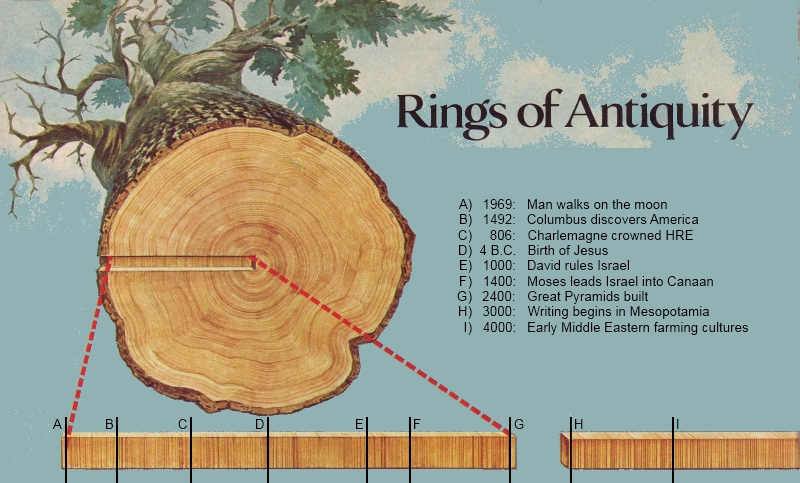At nearly 5,000 years of age,
bristlecone pines are revolutionizing man's understanding of climate,
history and archaeology.
High in the mountains of the southwestern United States, the twisted, misshapen and battered forms of bristlecone pines cling precariously to the sparse soil that somehow sustains them. But the stunted, gnomish appearance of the bristle-cones belies their incredible age — an awesome antiquity that antedates recorded history. Indeed, in the White Mountains of California, nearly 20 bristle-cones have lived more than 4,000 years. One tree, known as Methuselah, is over 4,600 years old. The Methuselah tree was already hundreds of years old when the Egyptians built the Great Pyramid. It had lived over a millennium when Moses led the Israelites out of Egypt. And it had survived over 3,000 mountaintop winters when Charlemagne was proclaimed emperor of the Holy Roman Empire in A.D. 800. An even older bristlecone pine, growing in Nevada, was regrettably cut down in 1964. Its age: at least 4,900 years! In addition, dead bristlecone logs and stumps have been found that were living over 8,000 years ago.
How do we know the bristle-cones are thousands of years old? The answer is quite simple: Every year most trees add a growth ring of new wood. By counting these annual rings, the tree's age can be determined.

An ancient bristlecone pine still clings to life, it's twisted torso
sculptured by the elements. Photo by David Muench
|
Under ideal conditions, trees may grow quite rapidly, leaving easily discernible annual rings. But bristle-cone pines grow in arid, hostile environments where growth can literally be microscopic. In fact, bristle-cones may grow so slowly that the annual rings may be only a few thousandths of an inch thick — requiring a microscope to be clearly seen!
Matching Trees: Cross Dating
Perhaps even more amazing is that tree-ring chronologies are not limited by the age of the oldest tree. By cross-dating the inner tree rings of an old living tree with those in dead stumps and logs, scientists have built up an impressive sequence of bristlecone tree rings extending over 8,200 years into the past (see accompanying box).
Dendrochronologists (scientists who measure time by counting growth rings) have found that tree-ring chronologies extending back hundreds or thousands of years are very useful in historical and archaeological studies. For example, when an archaeologist finds a wooden beam that was used in an ancient building, he can often date the dwelling by matching the pattern of tree rings in the beam with a master tree-ring chronology for that area. This technique has been especially helpful in dating Indian ruins in the American Southwest.
Tree rings also provide a natural source of information about localized weather and climate patterns prior to man's records. The date can be found by counting the tree's rings, and the climate is determined by studying the size, density and other characteristics of those rings. Obviously, when the rings are small, we would expect their growth was limited by some climatic factor — usually rainfall.
|
Dendrochronologists Dr. Valmore C. LaMarche and Dr. Harold C. Fritts have demonstrated that we can acquire a greater understanding of climatic fluctuations and weather patterns over the past several thousand years by examining bristlecone tree-ring patterns. Such studies, they believe, give valuable insights into future climatic trends, such as the potential for a new ice age.
|
Illustration by Frank Germain
 |
|
Bristlecone tree-ring chronologies can be extended thousands of years through the technique of cross-dating. Since tree rings vary in shape and structure — depending on climatic conditions extant when they were formed — a unique tree-ring pattern or "fingerprint" is produced over a period of years. By matching the inner tree-ring patterns of a living tree with the outer rings of even older dead stumps or logs, a cross-dated continuous sequence of annual rings can be established. As shown schematically, a living bristlecone, such as the 4,600-year-old Methuselah tree, is actually only the first link in a tree-ring chronology which now extends over 8,200 years.
|